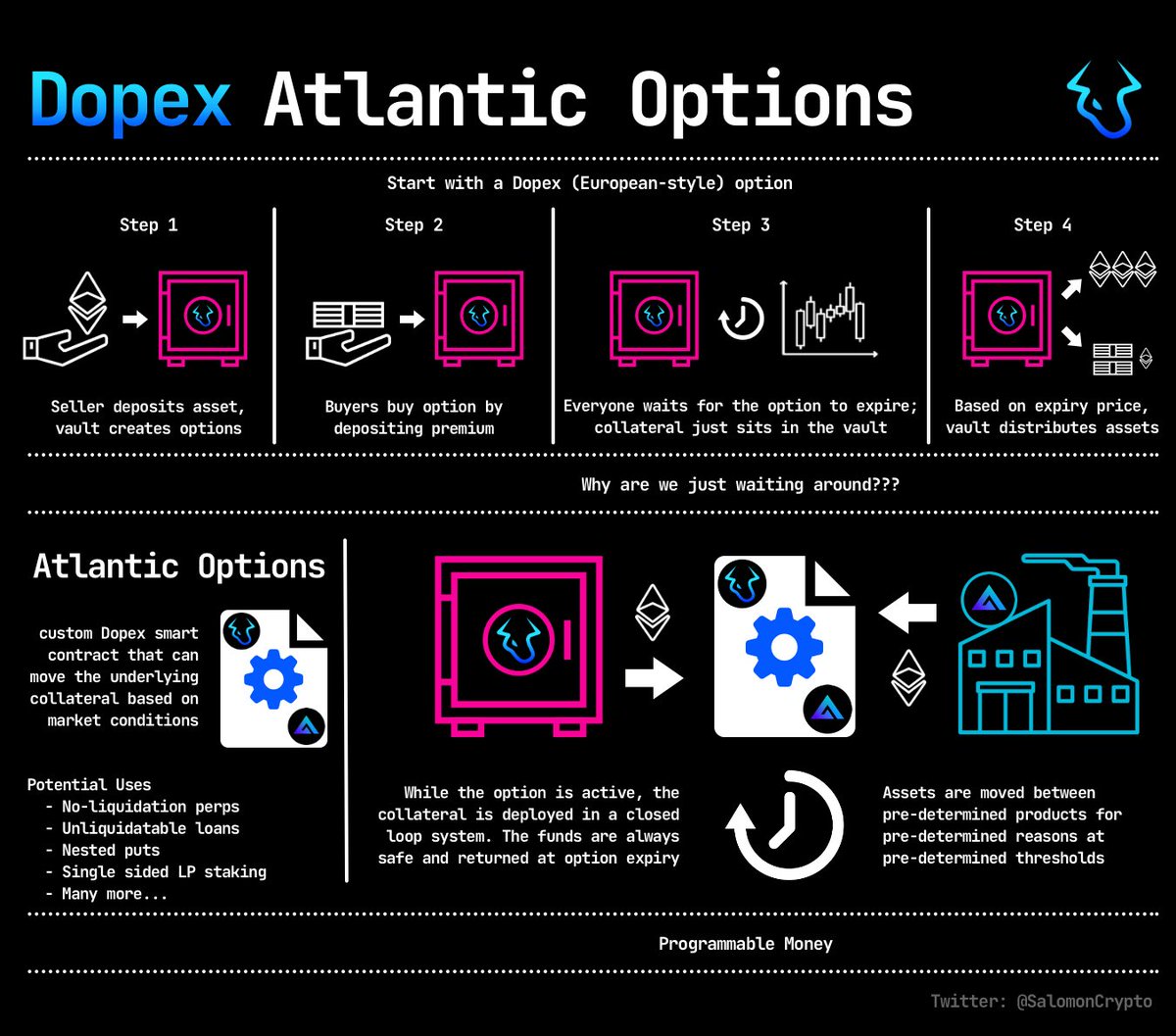
(1/19) Over in our little corner of De-Fi, big things are happening. As we build more and more tech, blockchain’s killer app is finally becoming clear:
Programmable Money
Read on to learn more about programmable money and why you should be PUMPED for De-Fi and @ethereum.
Programmable Money
Read on to learn more about programmable money and why you should be PUMPED for De-Fi and @ethereum.
(3/19) I remember when @VitalikButerin announced @ethereum to the world. Back then, and for the next ~6 years, my thoughts would drift between “I guess we have internet money now, or whatever” and “scam lol.”
Not anymore.
Not anymore.
(4/19) I’m bullish on @ethereum, De-Fi and crypto. Like really really bullish.
As I look at the real world, I see a world without trust and one that cannot coordinate. The old systems don’t work; we need something new.
We need The World Computer.
As I look at the real world, I see a world without trust and one that cannot coordinate. The old systems don’t work; we need something new.
We need The World Computer.
https://twitter.com/salomoncrypto/status/1522950619224453121
(5/19) Just think of the promise! Coordination without the nation-state, new paradigms of computing, peer-to-peer coordination, stable monetary policy, and on and on.
But as a finance nerd, the thing that gets me real pumped is already starting to appear:
Programmable money.
But as a finance nerd, the thing that gets me real pumped is already starting to appear:
Programmable money.
(6/19) We’ve had bartering forever, then precious/rare metals & gems, next paper bills and now it’s all just accounting and reserve accounts.
Until now, money has been like concrete; building starts from scratch and is bespoke to each individual project.
Until now, money has been like concrete; building starts from scratch and is bespoke to each individual project.
(7/19) Programmable money is something entirely new. If money is concrete, programmable money is like Legos.
Each protocol takes in plastic (value) and produces Lego-bricks (usually tokens). These bricks can be combined with other bricks to create something custom and new.
Each protocol takes in plastic (value) and produces Lego-bricks (usually tokens). These bricks can be combined with other bricks to create something custom and new.
(8/19) Everything in Trad-Fi is single step and based on relationships:
- develop relationship with bank, take a loan
- identify business, negotiate deal, buy business
- maintain operations in order to maintain yield
Time: a lot
Effort: a lot
Permission: a lot
- develop relationship with bank, take a loan
- identify business, negotiate deal, buy business
- maintain operations in order to maintain yield
Time: a lot
Effort: a lot
Permission: a lot
(9/19) Programmable money?
- deposit into @AaveAave, take out a loan
- identify yield farm, deposit, maybe (auto)compound
- withdraw
Time: 15-20 mins?
Effort: Twitter research and ~3 transactions
Permission: wtf is permission?
- deposit into @AaveAave, take out a loan
- identify yield farm, deposit, maybe (auto)compound
- withdraw
Time: 15-20 mins?
Effort: Twitter research and ~3 transactions
Permission: wtf is permission?
(10/19) This isn’t just about permission or usability. Programmable money allows us to combine individual ideas to create solutions and systems we couldn’t even imagine before.
For example…
For example…
(11/19) Over on @arbitrum, @UmamiFinance has cooked up (at least 1) vault that builds a new solution out of money-Legos.
Goal: capture @GMX_IO’s $GLP yield without being exposed to asset prices
Solution: combine $GLP with @TracerDAO short positions to hedge out asset price.
Goal: capture @GMX_IO’s $GLP yield without being exposed to asset prices
Solution: combine $GLP with @TracerDAO short positions to hedge out asset price.
https://twitter.com/salomoncrypto/status/1527339591212335104
(12/19) Purpose: @UmamiFinance has created a vault that provides the return of the top exchange on @arbitrum but without any of the risks or volatility inherent to crypto.
(13/19) Or check out the NFT world!
Goal: create deep, robust floor values for NFT collections
Solution: using @NFTX_, collections can prepare their NFTs for De-Fi. @FloorDAO, an OHM-fork, permanently buys and LPs these NFT.
Goal: create deep, robust floor values for NFT collections
Solution: using @NFTX_, collections can prepare their NFTs for De-Fi. @FloorDAO, an OHM-fork, permanently buys and LPs these NFT.
https://twitter.com/salomoncrypto/status/1537248026003001344
(14/19) Purpose: Collections with liquid floors are healthy collections. We can talk about why, but there’s a specific reason why were doing this…
NFT collections with deep, liquid floors can be liquidated. If they can be liquidated, they can be borrowed against
@JPEGd_69 👀
NFT collections with deep, liquid floors can be liquidated. If they can be liquidated, they can be borrowed against
@JPEGd_69 👀
(15/19) I think the coolest example is over at @dopex_io.
Goal: unlock capital efficiency by allowing users/protocols to access the collateral deposited in option vaults
Solution: Atlantic Options
Goal: unlock capital efficiency by allowing users/protocols to access the collateral deposited in option vaults
Solution: Atlantic Options
https://twitter.com/salomoncrypto/status/1535709102080307200
(16/19) Purpose: provide a world of new financial products and opportunities…
- No-liquidation perps and loans
- Automatic hedging
- Single sided LP staking
- Nested puts
- algorithmic opportunistic buying/selling
- whatever you can imagine!!!
- No-liquidation perps and loans
- Automatic hedging
- Single sided LP staking
- Nested puts
- algorithmic opportunistic buying/selling
- whatever you can imagine!!!

(17/19) Programmable money is kind of a confusing and poorly defined idea, but it’s implications are infinite.
The secret sauce is in smart contracts and their ability to understand context and make decisions.
The secret sauce is @ethereum!
The secret sauce is in smart contracts and their ability to understand context and make decisions.
The secret sauce is @ethereum!
(18/19) As you venture out on-chain and into the unknown, keep the concept of programmable money in the back of your head:
- what does this protocol output?
- which protocols accept this output as an input?
- how can I build something greater than the sum of its parts?
- what does this protocol output?
- which protocols accept this output as an input?
- how can I build something greater than the sum of its parts?
(19/19) Together, we will build the financial system of the future… for our grandkids and their grandkids and on and on…
One money-Lego at a time!
One money-Lego at a time!
Like what you read? Help me spread the world by retweeting the thread (linked below).
Follow me for more explainers and as much alpha as I can possibly serve.
Follow me for more explainers and as much alpha as I can possibly serve.
https://twitter.com/salomoncrypto/status/1537445163886252032
• • •
Missing some Tweet in this thread? You can try to
force a refresh





